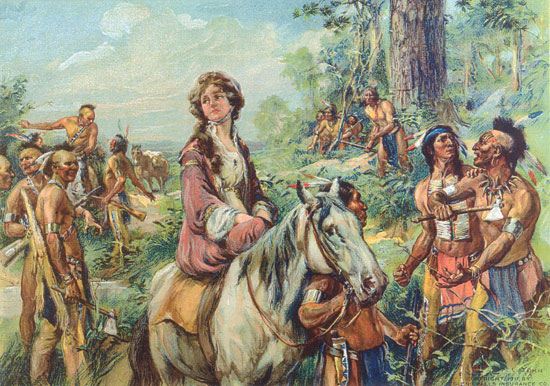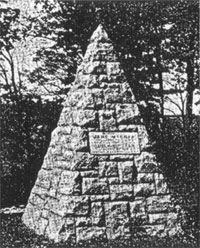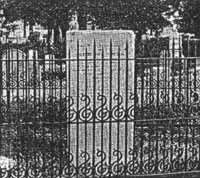| |

JANE McCREA, "the beautiful
betrothed maiden of the Hudson,"
seems to have been selected by
Providence as a sacrifice to arouse
the drooping spirit of Liberty in the midsummer of 1777.
The Revolutionary War furnished
no single incident which created more intense interest and sympathy, or aroused
more desperate indignation, than the
savage murder of this lovely girl.

Monument near the spot where Jane McCrea was killed.
Erected by the Jane McCrea Chapter, D.A.R. |
Her youth, personal beauty, attractive qualities and the peculiar circumstances
of the tragedy, invest the story
with such romantic pathos as to attract
the artist, poet and historian. Its interest is also enhanced by the fact that her
murder contributed to the success of the
Colonial arms in the memorable events
which followed. It so thrilled and
stirred the then discouraged patriots as
to hasten bands of resolute men to the
American camp, determined to resist to
the death an invading enemy guilty of
employing such savage auxiliaries.
How much the defeat of Burgoyne
and the making of Saratoga one of the
few decisive battles of all history may be
attributed to this righteous indignation
has been the subject of much speculation, but it is conceded to have been an
important factor.
In the various records of this affair
there is much that is conflicting, but the following brief sketch is submitted as fairly authentic: Jane McCrea was an orphan living
with her brother, John McCrea, on a newly cleared farm on the Hudson River, below
Glens Falls and near Fort Edward. She came from New Jersey, and was the daughter
of a scholarly Presbyterian clergyman, who gave personal attention to the education of
his daughter. At the time of her murder she was about eighteen years of age, "of middling
stature. finely formed and uncommonly beautiful." Another writes of her as "graceful of
manner, intelligent and lovely of features, and a favorite of all who knew her.
The Jones family were neighbors of the McCreas. in New Jersey, and following them
to the wilds of the Upper Hudson became neighbors again. One of the Jones boys,
David, was "a handsome, manly young man; brave, generous, and with a grace much
in contrast with the rough-mannered youth of this wilderness region." "Jenny," as Miss
McCrea was called, and David had been children together, and an early attachment in
New Jersey ripened into fullness of devoted love on the banks of the Hudson. The long
friendship between these families was broken by the war. John McCrea was a Patriot:
David Jones was a Tory, and bitterness resulted.
When Burgoyne was making ready in Canada his great invasion of the Colonies in
1777, David Jones and his brother joined Burgoyne's army there and David was made a
lieutenant, while John McCrea became a colonel in the Colonial army. Finally, Burgoyne,
with his fierce Indian allies, reached a little north of Glens Falls and threateningly
near Fort Edward. Here he remained some time and Lieutenant Jones was able to correspond
with Miss McCrea. Despairing of securing her brother's approval, knowing her
unhappy situation and sure that she would be removed with other settlers for safety to
Albany when Burgoyne should advance,. it was arranged that she should join him and be
married at once. Miss McCrea was to visit her friend Mrs. McNeil, of Fort Edward (a
kinswoman of General Frazier, serving with Burgoyne), and on that fateful Sunday
morning of July, 1777, she was to proceed alone, direct to the British lines, where the ladies, officers' wives accompanying the expedition, would arrange the wedding.
While it was believed she could proceed the short distance alone better than with an
escort which would be likely to provoke attack, it was, however, arranged that Duluth,
an Indian chief and the friend of Jones, with a few of his savage band, should steal his way
through the woods to near Fort Edward, signal his presence to the watching girl and hover
near her as she proceeded, but not to discover themselves unless danger threatened her.
"Giving much care to her toilet and dress, putting on her best for her nuptials, she started
from her friend's house." Going up the slope from the river, through the ravine where
the railway now runs, she was startled by musketry and the war-whoop of savages at the
top of the slope, and in fright ran back towards Mrs. McNeil's house.

Grave of Jane McCrea.
Union Cemetery, between Hudson Falls and Fort Edward, NY.
Not far from where she was killed. |
A marauding band of savages, under Le Loup (The Wolf), returning from a murdering
and plundering raid, came upon an American outpost. Lieutenant Van.Vechten,
commanding, and others were killed, and the rest driven in. The savages saw Miss
McCrea fleeing and pursued her. Capturing her, and placing her on one of their stolen
horses, they hurried her back up the slope: and reaching the "Giant Pine," at the roots
of which flowed a notable spring of water - resorted to by animals, Indians and woodsmen
as to be the center of radiating trails – they were confronted by Duluth and his
band. Duluth explained his mission and demanded the maiden that he might get the
promised reward for her safe delivery. Le Loup, coveting her attractive raiment, or
desiring the reward himself, claimed her as his captive.
While Miss McCrea, knowing that Duluth was her lover's trusted, messenger, was
calmly certain of soon reaching the British camp, the chiefs "hotly quarreled."' (The
sketch is intended to represent the situation at this time.) Finally,
Le Loup, in a frenzy of passion, rushed at Miss McCrea, and hurling his tomahawk with
deadly skill, murdered her. He flourished her scalp with ferocious exultation, and his
band stripping off her wedding raiment, all were hastened away by the returning outpost,
reinforced from the garrison at Fort Edward.
The spring, known as the "Jane McCrea Spring," still gurgles forth its pure waters,
but the "Giant Pine," after continuing a conspicuous and somber sentinel of the tragic
spot For seventy-five years,
was felled in 1853 and made
into canes and curious boxes
which were sold as souvenirs at the New York Crystal Palace Exposition.
Miss McCrea's remains,
twice removed, now rest in
the Union Cemetery at
Hudson Falls, just over the
brow of the slope where she
was murdered. Over "the
poor handful of earth " the
affection of a niece has raised
a graceful monument.
This artistic illustration
is an excellent reduced reproduction of a painting by
Mr. F. C. Yohn, owned by
the Glens Falls Insurance
Company.
The locality of this tragedy and the beautiful monument which marks the spot
of Burgoyne's surrender at
Schuylerville (then Saratoga)
may be seen from the tower
of the Glens Falls Insurance
Company's building.
Back to the Stories of the French & Indian and Revolutionary Wars. |


